
Looking for How to Freeze Pears at Home in 2025? Scroll down this page and follow the links. And if you bring home some fruit or vegetables and want to can, freeze, make jam, salsa or pickles, see this page for simple, reliable, illustrated canning, freezing or preserving directions. There are plenty of other related resources, click on the resources dropdown above. If you are having a hard time finding canning lids, I've used these, and they're a great price & ship in 2 days.
If you have questions or feedback, please let me know! There are affiliate links on this page. Read our disclosure policy to learn more.
Freezing Pears for Home Storage
Pears store well in a cool, dry area, like a basement or root cellar, but over time, they do tend to dry out and get a wrinkly skin and Styrofoamy texture. Freezing retains the taste much better, and leaves them fine for cooked recipes. Here's how to freeze the pears, in easy steps. And see the bottom of the page for more notes about freezing pears without sweeteners.
Directions
 Step 1 - Selecting the pears
Step 1 - Selecting the pears
The most important step! You need pears that are ripe but not overripe. Keep in mind that pears are an unusual stone fruit - they continue to ripen AFTER you pick them. In fact, it is best to harvest them while they are still green and allow them to ripen in a cool dark place, to avoid insect damage and fungus.
Select full-flavored pears that are crisp and firm, not mealy in texture. Choose pears that are naturally sweet and flavorful - freezing won't improve a pear!
Step 2 - How many pears and where to get them
You can pick your own, or buy them at the grocery store. But for large quantities, you will find that real* farmer's markets, like the Farmer's Market in Forest Park, Georgia have them at the best prices. In 2009, they were available from late September at $11 to $16 per bushel. There is a wide variation in prices at the real farmer's markets, like the Atlanta-Forest park Georgia State Farmer's Market and orchards in the southeast of the U.S.
* - not the cutesy, fake farmer's markets that are just warehouse grocery stores that call themselves farmer's markets.
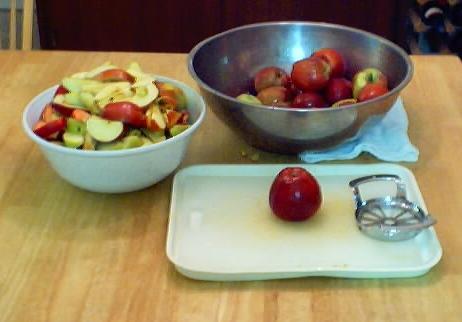 Step 3 -Wash the pears!
Step 3 -Wash the pears!
I'm sure you can figure out how to wash the pears in plain cold water.(yes, those are apples in the photo, but it's identical for pears!)
Step 4 - Choose your method and syrup
You can freeze the pears in a syrup, sugar, or dry, depending upon how you intend to use them later. A Syrup Pack is preferred for pears to be used for uncooked desserts or fruit cocktail. A sugar or dry pack is good for pie making. The dry pack can be used any way. The sugar and syrup pack methods are less likely to brown or have freezer burn.
- Syrup Pack - Use cold 40 percent syrup. (That is 2 cups of sugar added to every 3 cups of water. ) Of course, you can scale this up or down to suit the amount of pears you have. To prevent browning, add 1/2 teaspoon (1500 mg) ascorbic acid (also known as "FruitFresh ") to each quart of syrup.
- Sugar Pack - To prevent darkening, dissolve 1/2 teaspoon (1500 mg) ascorbic acid (also known as "FruitFresh ") in 3 tablespoons water. You will need 1/2 cup sugar per quart (1 1/4 pounds) of peeled, sliced pears.
- Dry Pack - To prevent darkening, dissolve 1/2 teaspoon (1500 mg) ascorbic acid (also known as "FruitFresh ") in 3 tablespoons water.
Step 5 - Peel the pears
The fastest way to peel the pears is one of these peelers! With firm pears, it takes about 20 seconds per apple. These apple peelers don't work well on soft, mushy pears or pears with soft spots on them. In that case your stuck with a hand peeler!
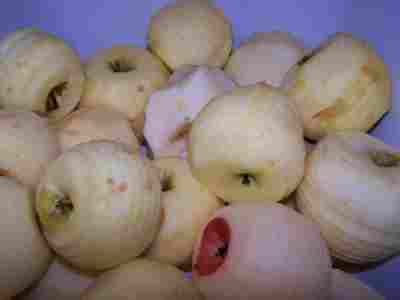 Once they're peeled, remove any remaining brown spots.
Once they're peeled, remove any remaining brown spots.These apple peelers work absolutely great on firm pears, apples and potatoes. They don't work so well on pears or apples that are mushy or have soft spots. There are 2 types of peelers: those that have a suction base ("Back to Basics", below) and those that clamp on to the edge of a table ("Progressive" below"). I prefer the suction type as you can use it more places. Click on the links below for more info or to order one.
See here for related tools, equipment, supplies on Amazon See here for related tools, equipment, supplies on Amazon
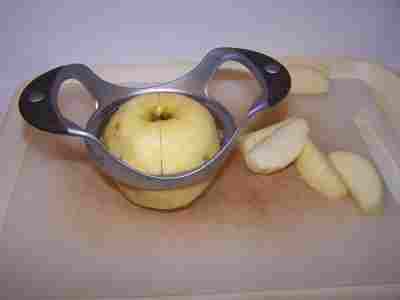 Step 6 - Core and Slice
Step 6 - Core and Slice
Slice medium pears into twelfths, large ones into sixteenths.
You can use a knife, but the $5 corer/slicer you see in the photo is the easiest way to do it. The apple corer/slicer, available at almost any large grocery store, kitchen store, Bed Bath and Beyond, mall kitchen stores, Target and other local "big box" stores
With this or an ordinary knife, any slices that are between 1/4-inch and 1/2 inch thick will do.
Remove seeds, stems, any hard parts near the seeds and brown or soft spots.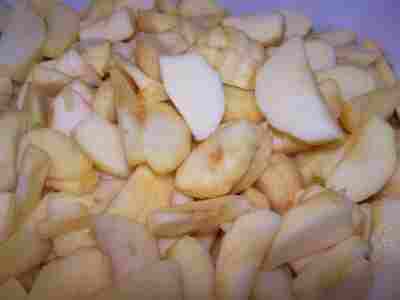
These corer/slicers are fantastic. Think about it; it makes six slices in the time you can cut one with a knife AND it cores. The one sold here is better than any I've seen in the stores because it has tall handles (so you won't knock your knuckles) and is washable in the dishwasher. Click on the link below for more info or to order one. They work well for apples and pears.
See here for related tools, equipment, supplies on Amazon
See here for related tools, equipment, supplies on Amazon
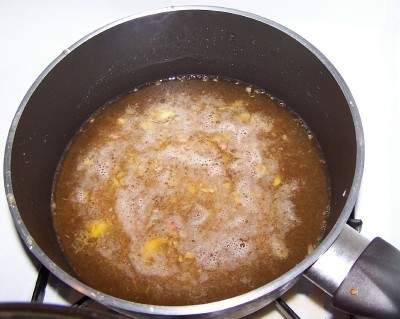
Step 7 - Heat the pears with the solution
Except for a dry pack, heat the pears in boiling 40 percent syrup for 1 to 2 minutes, depending on size of pieces. Drain and cool.
Dry pack notes: The dry pack is better suited towards for small whole fruits such as berries, that give a good quality product without sugar. If you do use it on pears, shake the fruit pieces with the ascorbic acid solution in a plastic bag or glass jar. How much fruit this will treat is very variable. Just make more if you need it!Step 8 - Pack the slices into your freezer containers
Pack the slices into your freezer containers (freezer bags or plastic freezer containers... or glass (but due to risk of breakage, I tend not to use glass in the freezer). In a wet pack, pour more sweetener over them to cover them completely. If you are using the dry pack approach, the treated pear slices can also be frozen first on a tray and then packed into containers as soon as they are frozen.
Step 9 - Freeze!
That's it! They're done. If your freezer is good and cold (below 25 F) they should keep for many months. Try to avoid frost-free freezers, as they cycle briefly above freezing!
Unsweetened Packs for Freezing Fruits
Dry Pack
The dry pack is good for small whole fruits such as berries, that give a good quality product without sugar. It's not as good for apples and pears, which brown when cut. Simply pack the fruit into a container, seal and freeze. A tray pack is an alternative that may make the fruit easier to remove from the container. Simply spread a single layer of prepared fruit on shallow trays and freeze. When frozen, promptly package and return to the freezer. The fruit pieces remain loose and can be poured from the container and the package re-closed. Be sure to package the fruit as soon as it is frozen, to prevent freezer burn.
Other Unsweetened Packs
In addition to a dry pack, unsweetened fruit can be packed in water, unsweetened juice or pectin syrup. Unsweetened packs generally yield a product that does not have the plump texture and good color of those packed with sugar. The fruits freeze harder and take longer to thaw. However, some fruits such as raspberries, blueberries, steamed apples, gooseberries, currants, cranberries, rhubarb and figs give a good quality product without sugar. The pectin syrup is often used for fruits such as strawberries or peaches, that retain their texture better than if frozen in water or juice.
Looking for canning equipment and supplies?
Water bath canner with a jar rack
Pressure canners for gas, electric and induction stoves: Presto 23Qt or T-fal 22Qt
Canning scoop (this one is PERFECT)
Ball Blue book (most recent version)
Jars: 8oz canning jars for jams
Find Other types of farms:
Farm markets and roadside stands
Road trips and camping resources
Local Honey, apiaries, beekeepers
Consumer fraud and scams information
Home canning supplies at the best prices on the internet!
Maple Syrup Farms, sugarworks, maple syrup festivals
Environmental information and resources
Farms For Your Event for birthday parties, weddings, receptions, business meetings, retreats, etc.
Festivals - local fruit and vegetable festivals
Get the
most recent version of
the Ball Blue Book
With this Presto 23 quart pressure canner and pressure cooker, you can "can" everything, fruits, vegetables, jams, jellies, salsa, applesauce, pickles, even meats, soups, stews. Model 01781

You can make jams, jellies, can fruit, applesauce, salsa and pickles with water bath canners, like this Granite Ware 12-Piece Canner Kit, Jar Rack, Blancher, Colander and 5 piece Canning Tool Set

